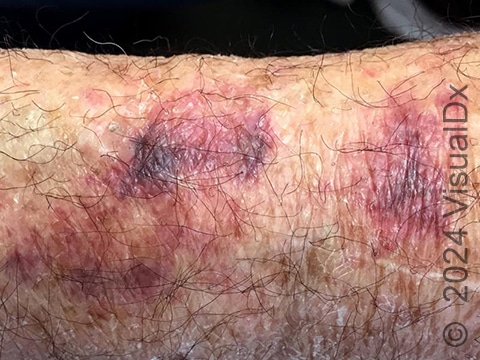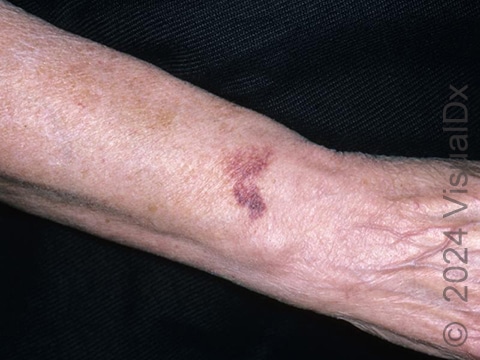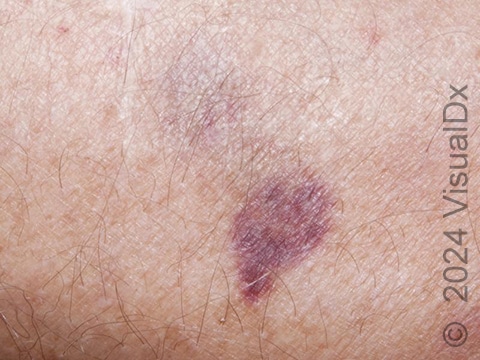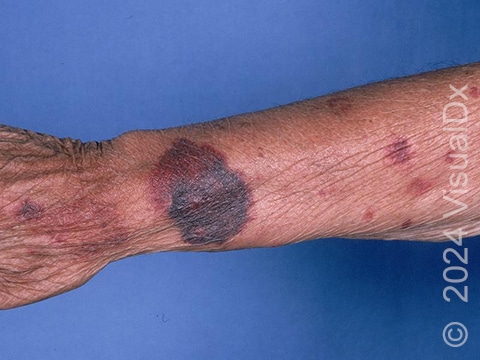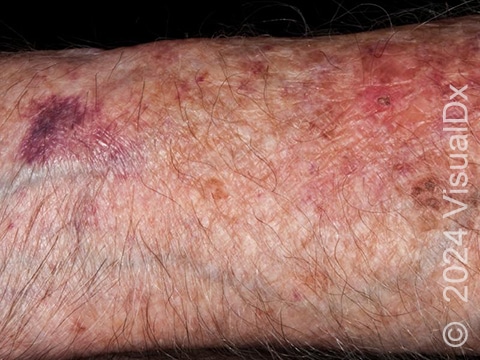Solar Purpura
Solar purpura refers to red blood cells leaking into previously sun-damaged skin. It usually occurs on the arms and the backs of the hands in older adults. The skin appears to be bruised, with dark-red-to-purple discoloration. The bruised appearance may not heal for 2 or 3 weeks.
Who's At Risk?
Older adults are most often affected, usually after minor injuries that went unnoticed. Prior overexposure to ultraviolet (UV) radiation from the sun weakens the blood vessels, allowing blood to escape under the skin. Solar purpura is more likely to occur in adults with long-term exposure to the sun, and it is most noticeable on people with lighter skin colors.
The chances of developing solar purpura are increased in people taking certain medications, such as corticosteroids, aspirin, blood thinners, and anticoagulants such as warfarin (eg, Coumadin).
Signs & Symptoms
Look for dark-red-to-purple macules (small, flat areas of skin color changes) and patches (flat areas of skin color changes larger than a thumbnail) on the arms, backs of the hands, legs, and sometimes the face and neck. You may or may not recall previously bumping the affected area of skin.
Self-Care Guidelines
Solar purpura is a common, harmless condition. Further exposure to the sun should be prevented by using a broad-spectrum sunscreen (one that protects against UVA and UVB rays) and by wearing sun-protective clothing such as long sleeves, long pants, wide-brimmed hats, etc. Wearing two layers of clothing to help minimize the effects of mild trauma to the skin may be helpful.
Treatments
A skin biopsy may be performed if the diagnosis is in doubt. Although solar purpura is harmless, your medical professional may recommend ways to speed up the healing process and to prevent further damage.
Visit Urgency
When areas of “bruising” appear without explanation, you should consult your medical professional to rule out other, more serious conditions and for advice on managing and healing the affected area.
References
Bolognia J, Schaffer JV, Cerroni L. Dermatology. 4th ed. Philadelphia, PA: Elsevier; 2018.
James WD, Elston D, Treat JR, Rosenbach MA. Andrew’s Diseases of the Skin. 13th ed. Philadelphia, PA: Elsevier; 2019.
Kang S, Amagai M, Bruckner AL, et al. Fitzpatrick’s Dermatology. 9th ed. New York, NY: McGraw-Hill Education; 2019.
Last modified on November 6th, 2024 at 9:21 am

Not sure what to look for?
Try our new Rash and Skin Condition Finder
